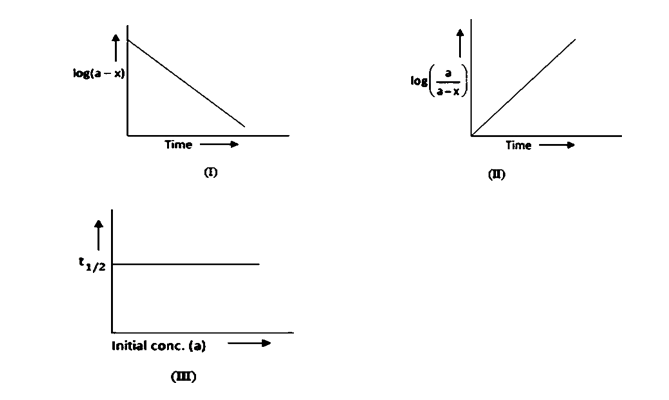Which of the following isomerization reactions is/are of the first order?
cis-But--eneTrans-but--ene
Vinyl allyl ether Pent--enal
The correct Answer is:A, B, C, D
To determine which of the given isomerization reactions are of the first order, we need to understand the definition of isomerization reactions and first-order kinetics.
1. Understanding Isomerization Reactions:
- Isomerization reactions involve the conversion of one isomer into another. Isomers are compounds that have the same molecular formula but different structural arrangements.
2. Identifying the Reactions:
- The question provides four options of isomerization reactions. We need to analyze each reaction to see if it fits the criteria for first-order kinetics.
3. Criteria for First-Order Reactions:
- A reaction is classified as first order if the rate of the reaction depends on the concentration of one reactant raised to the power of one. This means that the rate law can be expressed as:
Rate=k(A)1
- Here, k is the rate constant, and (A) is the concentration of the reactant.
4. Analyzing Each Option:
- For each of the provided isomerization reactions, we check if they have only one reactant and if the rate can be expressed as a function of that reactant's concentration raised to the first power.
- For example:
- Cyclopropane to Propene: The reaction can be expressed as Rate = k(cyclopropane)^1, indicating it is first order.
- Cis-Butyrene to Trans-Butyrene: Similarly, this can be expressed as Rate = k(cis-butyrene)^1, indicating it is first order.
- Other reactions: The same analysis applies to the remaining options.
5. Conclusion:
- Since all the reactions provided in the options have only one reactant and follow the first-order rate law, we conclude that all options (A, B, C, and D) are first-order reactions.
Final Answer:
All of the given isomerization reactions (A, B, C, and D) are of first order.
- Isomerization reactions involve the conversion of one isomer into another. Isomers are compounds that have the same molecular formula but different structural arrangements.
- The question provides four options of isomerization reactions. We need to analyze each reaction to see if it fits the criteria for first-order kinetics.
- A reaction is classified as first order if the rate of the reaction depends on the concentration of one reactant raised to the power of one. This means that the rate law can be expressed as:
Rate=k(A)1
- Here, k is the rate constant, and (A) is the concentration of the reactant.
- For each of the provided isomerization reactions, we check if they have only one reactant and if the rate can be expressed as a function of that reactant's concentration raised to the first power.
- For example:
- Cyclopropane to Propene: The reaction can be expressed as Rate = k(cyclopropane)^1, indicating it is first order.
- Cis-Butyrene to Trans-Butyrene: Similarly, this can be expressed as Rate = k(cis-butyrene)^1, indicating it is first order.
- Other reactions: The same analysis applies to the remaining options.
- Since all the reactions provided in the options have only one reactant and follow the first-order rate law, we conclude that all options (A, B, C, and D) are first-order reactions.
All of the given isomerization reactions (A, B, C, and D) are of first order.
Topper's Solved these Questions
- CHEMICAL KINETICSBOOK - CENGAGE CHEMISTRY ENGLISHCHAPTER - CHEMICAL KINETICSEXERCISE - Exercises Single Correct
177 Videos
- CHEMICAL KINETICSBOOK - CENGAGE CHEMISTRY ENGLISHCHAPTER - CHEMICAL KINETICSEXERCISE - Exercises Assertion-Reasoning
22 Videos
- CHEMICAL KINETICSBOOK - CENGAGE CHEMISTRY ENGLISHCHAPTER - CHEMICAL KINETICSEXERCISE - Exercises Linked Comprehension
59 Videos
- CARBOXYLIC ACIDS AND THEIR DERIVATIVESBOOK - CENGAGE CHEMISTRY ENGLISHCHAPTER - CARBOXYLIC ACIDS AND THEIR DERIVATIVESEXERCISE - Exercises Archives (Analytical And Descriptive)
34 Videos
- COORDINATION COMPOUNDSBOOK - CENGAGE CHEMISTRY ENGLISHCHAPTER - COORDINATION COMPOUNDSEXERCISE - Archives Subjective
18 Videos
Similar Questions
Which of the following reaction (s) is / are of the first order ?
View SolutionWhich of the following is a first order reaction:
View SolutionWhich of the following shows coordination isomerism?
View SolutionWhich of the following is/are correct for the first order reaction ? (a is initial concentration of reactant, x is concentration of the reactant reacted and t is time)

View SolutionWhich of the following is/are correct about the first order reaction ?
View SolutionWhich of the following reaction is not of the first order ?
View SolutionWhich of the following is/are correct for the first order reaction?

View SolutionWhich among the following reactions is can be a example of pseudo first order reaction?
View SolutionWhich of the following expression is correct for first order reaction? Ao refers to initial concentration of reactant
View SolutionWhich of the following is correct for a first order reaction ?
View Solution
